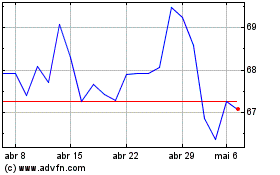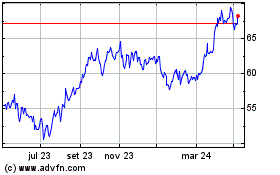By Christopher M. Matthews
Big oil companies endured one of their worst second quarters
ever and are positioning themselves for prolonged pain as the
coronavirus pandemic continues to sap global demand for fossil
fuels.
Exxon Mobil Corp. posted a quarterly loss for the second
straight quarter for the first time this century on Friday,
reporting a loss of $1.1 billion, compared with a profit of $3.1
billion a year ago. Exxon, the largest U.S. oil company, hadn't
reported back-to-back losses for at least 22 years, according to
Dow Jones Market Data, whose figures extend to 1998.
"The global pandemic and oversupply conditions significantly
impacted our second-quarter financial results with lower prices,
margins, and sales volumes," Exxon Chief Executive Darren Woods
said.
Chevron Corp. said Friday it lost $8.3 billion in the second
quarter, down from $4.3 billion in profits during the same period
last year, its largest loss since at least 1998. It wrote down $5.7
billion in oil-and-gas properties, including $2.6 billion in
Venezuela, citing uncertainty in the country ruled by strongman
Nicolás Maduro. Chevron also said it lowered its internal estimates
for future commodity prices.
Royal Dutch Shell PLC and Total SA reported significant losses
in the second quarter earlier this week, as the impact of the
pandemic and a worsening long-term outlook for commodity prices
spurred them to write down the value of their assets.
The dismal results are ratcheting up the problems for the oil
giants, which were struggling to attract investors even before the
pandemic, as concerns over climate-change regulations and
increasing competition from renewable energy and electric vehicles
cloud the future for fossil fuels.
Holdings of oil-and-gas stocks by active money managers are at a
15-year low, according to investment bank Evercore ISI. BP PLC,
Shell and Total are all trading at 30-year lows relative to the
overall S&P 500. Exxon is trading at its lowest level to the
S&P 500 since 1977, according to the bank.
Many of the big oil companies have sought to retain investors
despite slowing growth and profits over the past decade by paying
out hefty dividends, but those payouts are proving hard to sustain
during the pandemic.
Crude prices have stabilized at around $40 a barrel, providing
modest relief for the industry after U.S. oil prices briefly turned
negative for the first time ever in April. But none of the world's
largest oil companies now foresee a rapid recovery as countries
continue to struggle with containing the coronavirus.
Chevron CEO Mike Wirth said his company faced an uncertain
future for energy demand and couldn't predict commodity prices with
confidence right now.
"We expect a choppy economy and a choppy market," Mr. Wirth said
in an interview earlier in July. "It all depends on the virus and
the policies enacted to respond to it."
Oil and gas production by both Exxon and Chevron decreased in
the quarter, down 7% and 3%, respectively, from a year ago, as the
companies shut off wells to avoid selling into a weak market.
Exxon's production-and-exploration business lost $1.7 billion,
which Exxon attributed to lower commodity prices. Chevron's
production unit lost $6.1 billion.
U.S. oil prices closed below $40 per barrel Thursday for the
first time in three weeks.
For the entire second quarter, U.S. oil prices averaged $28 per
barrel and Brent crude averaged about $33, according to Dow Jones
Market Data, prices at which even the largest oil companies
struggle to turn a profit, analysts say.
While major stock indexes have recovered from April, when they
fell to their lowest levels in years, oil and gas stocks have
continued to lag despite the slight rebound in commodity
prices.
Many of the world's largest energy companies, including Exxon
and Chevron, have for years used an integrated business model,
which has historically allowed them to weather most market
conditions.
By owning oil and gas wells, along with the downstream plants to
manufacture refined products like gasoline and chemicals, the
companies were long able to capitalize in one sector of their
business, regardless of whether oil prices were high or low.
But that model has failed to deliver strong returns for most of
the past decade, as the world has faced a glut of fossil fuels
triggered in part by America's fracking boom, and it isn't
protecting the companies now, according to Evercore ISI analyst
Doug Terreson.
"A broad-based reassessment of the capital-management programs
at the big oils is required at this point," Mr. Terreson said.
Oil companies have been forced to take dramatic action to shore
up their finances in recent months, including cutting tens of
billions of dollars from their budgets and laying off thousands of
employees.
Exxon, which had previously disclosed a 30% cut to capital
expenditures in 2020, said on Friday it has "identified significant
potential for additional reductions" and said capital spending in
2021 will be lower than this year's spending.
Its steepest cuts have been to U.S. shale drilling, particularly
in the Permian Basin, the most active U.S. oil field, where it
removed half of its drilling rigs and will cut half of the
remaining 30 rigs by the end of year. Chevron is operating just
four rigs in the Permian and said production there would decline
around 7% this year.
Shell in April cut its dividend for the first time since World
War II to avoid having to borrow to fund it. It reported a
second-quarter loss of $18.4 billion on Thursday, which included a
$16.8 billion write-down, while French giant Total posted an $8.4
billion loss including an $8.1 billion write-down. Both companies
report net income attributable to shareholders, a proxy for net
profits. BP reports Tuesday.
Excluding impairments, Shell and Total actually turned a profit
during the quarter as their trading units helped stave off even
larger losses.
Exxon and Chevron have promised they will maintain their
dividends, viewed by many investors as the most attractive part of
owning their stocks. Some analysts predict Exxon may be forced to
cut its dividend in 2021 if market conditions don't recover.
Exxon's dividend payments cost the company almost $15 billion a
year. The company's debt grew by $8.8 billion in the quarter,
according to Goldman Sach Group Inc., which said Exxon will need
oil prices around $75 per barrel in 2021 to cover its dividend
payments from cash flow. Exxon said Friday it wouldn't take on
additional debt.
Dan Pickering, chief investment officer of energy investment
firm Pickering Energy Partners LP, said the industry can survive at
$40 oil but needs significantly higher prices to thrive. According
to Mr. Pickering, who said he holds small positions in Exxon and
Chevron, oil companies will have to continue cost-cutting for the
foreseeable future.
"You've got to assume that this is the world we're going to be
in, Mr. Pickering said. "And, if this is the world we're going to
be in, the cost structure is too high."
--Dave Sebastian contributed to this article.
Write to Christopher M. Matthews at
christopher.matthews@wsj.com
(END) Dow Jones Newswires
July 31, 2020 14:16 ET (18:16 GMT)
Copyright (c) 2020 Dow Jones & Company, Inc.
TotalEnergies (EU:TTE)
Gráfico Histórico do Ativo
De Out 2024 até Nov 2024

TotalEnergies (EU:TTE)
Gráfico Histórico do Ativo
De Nov 2023 até Nov 2024


